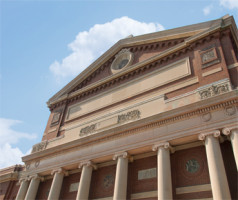Of Light through the Clouds
|
Dan Albertson [April 2014.] [Thank you, David McCadden, and good luck to you, Clive Liu!]
[image from http://www.bso.org/media/48321/OusideSymphonyHall_345x290.jpg] Claude DEBUSSY: Nuages and Fêtes from Nocturnes (1894-99). Bernard RANDS: Concerto for Piano and Orchestra (2013, première)*. Sergei RACHMANINOFF: Symphonic Dances, Op. 45 (1940). Jonathan Biss (pf)*, Boston Symphony Orchestra, Robert Spano (cond.). Symphony Hall, Boston, Apr. 3 & 4, 2014. http://www.bso.org/ As the main reason for my attendance at this concert was the new Concerto by Bernard Rands, the other works will get short shrift in this evaluation. The performance of the orphaned Nocturnes was neither incisive nor insightful; Spano was content to let the orchestra meander in the first nocturne and turned in a most un-festive reading of the second nocturne, more like an exhibit of muscle memory than an interpretation. I will stick with Charles Münch. The durations were 7:54 and 6:44 on Thursday, then 7:45 and 6:45 on Friday. The Symphonic Dances were more cogent, but turgid passages muddied the larger picture. I think especially of an interminable rendering of the middle of the third movement, its grey strings stretching out the music almost into infinity, and of the absence of tense rubato in the second movement, a safe, comfortable take on a movement that should disturb. Throughout the evening, I wondered if too many years immersed in Sibelius have left the orchestra afraid to express a joy unaccompanied by melancholy, though this trait is far from a drawback here. The durations were 12:10, 10:10 and 14:17 on Thursday, then 12:05, 10:14 and 14:19 on Friday. If anyone cares, Spano opted for the final stroke of the tam-tam to resonate, though applause covered it up on both days. I admit that the first audition of the Concerto left me quite cold. The music, while thoughtful, presented a fair amount of hesitation without a commensurate amount of delayed rewards. The concert on Friday, though, found the orchestra in a more cohesive state, with better balances and inner dialogues more present in the texture, giving me a clearer angle on its intentions. The music itself is sometimes brash, sometimes filled with finesse, but always self-assured. The piano remains taciturn during a solemn, striking introduction. A jostling for position overtakes the first movement, as the piano struggles, not always successfully, to find ways to fit into its orchestral surroundings. The middle movement is the most memorable of the work. It begins with a slow-moving cantilena in the low strings, which gradually swells to infect the entire body of strings. The piano states a short theme and mostly retains its subdued character even as the orchestra undergoes a large amount of transformation around it. Low flutes and high strings are especially compelling. The finale features elements from convention, including material from earlier in the piece and even a cadenza, but never descends into a virtuosic showpiece. Indeed, the cadenza was a disappointment, as rather than enlivening the movement and anticipating the close of the piece after recapitulating its themes, it only interrupted the inevitable progress of the music. Perhaps the fact that the cadenza is fixed rather than improvised is to blame. The movement itself is, cadenza aside, a moto perpetuo at a moderate tempo, with too many trills and tremolandi; in performance, I longed for more hints of the playful that the composer marks in his description of the movement. The score closes as the piano quietly winds down over hovering notes from the vibraphone. The Concerto is, contrary to its title, much more a series of interactions between piano and different sections of the orchestra. It forces the listener to deal with postponed gratification, in a structural way similar to the post-1960s work of Witold Lutosławski, but I wonder if its rewards would have been higher were the risks greater. Is it conservative? Not exactly. Is it adventurous? Not exactly. Must it be either? No. Beyond my quibbles, my overriding impression is of a work at turns agitated, earnest and meditative, with the orchestral parts being more charismatic than the solo lines, as is often the case with concertante music. I commend the composer for not succumbing to the temptation of a bravura “signature piece” that its pianist, Jonathan Biss, could use as a calling card. I found the lack of a need to show off prowess in orchestration quite refreshing in a time when American composers are constantly regurgitating the Rimsky-Korsakov handbook. Percussion is used sparingly, though it becomes more prominent in the finale, and the winds and brass are treated as real, variegated sections instead of masses or, worse, as window-dressing. In not showing off, the true composer displays his craft. The durations were 7:58, 10:23 and 8:50 on Thursday, then 8:03, 10:56 and 8:50 on Friday.
[More Dan Albertson]
[Previous Article:
Ensemble Klang’s Colors and Melodies]
[Next Article:
Used Bin Troll Tweets G.]
|
